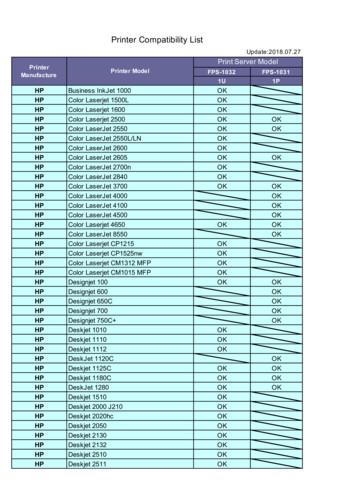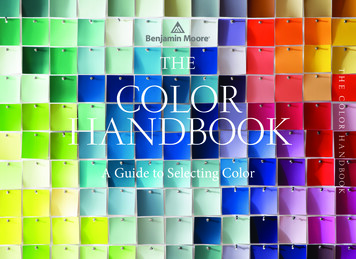Color - Dspace.mit.edu
ColorFrédo Durand and Barb CutlerMIT- EECSMany slides courtesy of Victor Ostromoukhov and Leonard McMillan
Why is the sky blue part II What do you mean exactly by blue?Color Vision2
Admin Quiz on Thursday– 1 sheet of notes allowed Review session tonight 7:30Color Vision3
Review of last weekColor Vision4
Monte Carlo Recap Random rays to sample rendering equation No meshing required, no special storage No limitation– On reflectance– On geometry Can be noisy (or slow Advanced1n)– Irradiance cache– Photon mapColor Vision5
You believe you know it all Color is about spectrumand wavelength We can get everythingfrom red, green and blue Well, life is moreconfusing than that!Color Vision6
Puzzles about color How comes a continuous spectrum ends upas a 3D color space Why is violet “close” to red Primaries: 3 or 4? Which ones– Red, blue, yellow, green– Cyan and magenta are not “spontaneous” primaries Color mixing What is the color of Henry IV’s white horse?Color Vision7
Plan Color VisionColor spacesProducing colorColor effectsColor Vision14
Cone spectral sensitivity Short, Medium and Long wavelengthS1.00M L0.750.500.250.00Color Vision400500 600wavelength70015
Cones do not “see” colorsM1.000.750.500.250.00Color Vision400500 600wavelength70016
Cones do not “see” colors Different wavelength, different intensity Same responseM1.000.750.500.250.00Color Vision400500 600wavelength70017
Response comparison Different wavelength, different intensity But different response for different conesS1.00M L0.750.500.250.00Color Vision400500 600wavelength70018
von Helmholtz 1859: Trichromatic theory Colors as relative responses(ratios)YellowOrangeRedShort wavelength receptorsRedOrangeYellowReceptor ResponsesGreenBlueVioletBlueGreenVioletMedium wavelength receptorsLong wavelength receptorsColor Vision400500600700Wavelengths (nm)19
Cones distribution In the retina LMS 40:20:1 No S (blue)in retina centerColor Vision20
Different spectrum Same responseINTENSITYMetamers400480 500580 600700INTENSITYWavelength (nm)400500600700Wavelength (nm)Color Vision21
Color matching Reproduce the color of atest lampwith the addition of 3primary lightsColor Vision22
Metamerism & light source Metamersunder a givenlight source May not bemetamersunder adifferentlampColor Vision23
Color blindness Dalton8% male, 0.6% femaleGeneticDichromate (2% male)– One type of cone missing– L (protanope), M (deuteranope),S (tritanope) Anomalous trichromat– Shifted sensitivityColor Vision24
Color blindness test Maze in subtle intensity contrast Visible only to color blinds Color contrast overrides intensity otherwiseColor Vision26
Plan Color Vision– Cone response, trichromats– Opponent theory– Higher-level Color spaces Producing color Color effectsColor Vision27
Remember von Helmholtz Colors as relative responses(ratios)YellowOrangeRedShort wavelength receptorsRedOrangeYellowReceptor ResponsesGreenBlueVioletBlueGreenVioletMedium wavelength receptorsLong wavelength receptorsColor Vision400500600700Wavelengths (nm)28
Hering 1874: Opponent Colors Hypothesis of 3 types of receptors: Red/Green, Blue/Yellow, Black/WhiteExplains well several visual phenomena 000---Color ptorsReceptors29
Dual Process Theory The input is LMS The output has a differentparameterization:– Light-dark– Blue-yellow– Red-greenMLSWhYRGBColor VisionTrichromaticOpponent-ProcessStageStageBk30
Color opponents wiring Sums for brightness Differences for color opponentsSML B Y-S-M-LColor Vision ML S-R G- M Y B- -L-M-ML W B-S M LL-S M LB W-G R---S-M-LM-L31
Simultaneous contrast In color opponentdirection Center-surroundColor VisionR G-B Y-G R-Y B-G R-B Y-R G-Y B-32
Land RetinexColor Vision33
Simultaneous Color ContrastColor Vision34
After-ImageColor Vision35
Opponent ColorsImageColor VisionAfterimage36
Opponents and image compression JPG, MPG Coloropponentsinstead ofRGB Compresscolor morethanluminanceColor Vision37
Plan Color Vision– Cone response, trichromats– Opponent theory– Higher-level Color spaces Producing color Color effectsColor Vision38
Color reparameterization The input is LMS The output has a differentparameterization:– Light-dark– Blue-yellow– Red-greenMLSWhYRB A later stage may reparameterize:– Brightness or Luminance or Value– Hue– SaturationColor VisionGBkL (or B)HS39
Hue Saturation ValueColor Vision40Courtesy of Stephen Palmer, VISION SCIENCE, and the MIT Press.Used with permission.
Hue Saturation Value One interpretationin spectrum space Not the only onebecause of metamerism Dominant wavelength(hue) Intensity Purity (saturation)Color Vision41
Color categories Prototypes Harder to classify colorsat boundariesDegree ofMembershipFocal GreenColor VisionFocal RedFocal BlueFocal YellowBlueYellow1(Red)0GreenRed(Blue)Hue42
Plan Color VisionColor spacesProducing colorColor effectsColor Vision43
Color spaces Human color perception is 3 dimensional How should we parameterize this 3D space Various constraints/goals––––Linear parameterizationClose to color technologyClose to human perceptionStandardColor Vision44
The root of all evil Cone responses are not orthogonal(they overlap) To change the M response without changing theL one, we need negative lightS1.00M L0.750.500.250.00Color Vision400500 600wavelength700Orthogonal basis (color matching function)45
Color Matching Problem Some colors cannot be produced using onlypositively weighted primaries E.g. primaries: pure wavelength– 650, 530, 460 Some colors need negative amounts ofprimaries Analysis spectrum hasnegative lobesColor Vision46
Color Matching Problem Some colors cannot beproduced using onlypositively weightedprimaries Solution: add light onthe other side!Color Vision47
Color Matching Problem Some colors cannot be produced using onlypositively weighted primaries Some tradeoff must be found betweennegative lobes in analysis vs. synthesis In 1931, the CIE(Commission Internationale de L’Eclairage)defined three new primaries Called X, Y , Z,– with positive colormatching functionsColor Vision48
CIE color space Can think of X, Y ,Z as coordinates Linear transform fromRGB or LMS(( ((( (RGBXYZ 3.24 -1.54 -0.50-0.97 1.88 0.040.06 -0.20 -1.06 0.410.210.020.36 0.180.72 0.070.12 0.95y(( ((( (XYZRGBxzColor Vision49
CIE color space Odd-shaped conecontains visible colors– Note that many pointsin XYZ do notcorrespond to visiblecolors!(( ((( (RGBXYZ 3.24 -1.54 -0.50-0.97 1.88 0.040.06 -0.20 -1.06 0.410.210.020.36 0.180.72 0.070.12 0.95y(( ((( (XYZRGBxzColor Vision50
CIE color space Objective, quantitative color descriptions– Dominant wavelength: Wavelength “seen” (corresponds to Hue)– Excitation purity: Saturation, expressed objectively– Luminance: Intensity Chromaticity (independent of luminance):– normalize against X Y Z:Color Vision51
CIE color space Spectrally pure colorslie along boundary Note that some huesdo not correspond toa pure spectrum(purple-violet) Standard white light(approximates sunlight)at 0.1490Blue480 Purple4000.1YellowCC580600Red7000.2 0.3 0.4 0.5 0.6 0.7 0.8xImage adapted from:Hunt, R. W. G. The Reproduction of Colour. John Wiley & Sons Incorporated. September2004. ISBN: 0-470-02425-9.Color Vision52
CIE color space Match color at somepoint A A is mix of whiteC, spectral B! What is dominantwavelength of A? What is excitationpurity (%) of A?– Move along AC/BCy0.80.7520540510B 0G0.2 0.3 0.4 0.5 0.6 0.7xImage adapted from:Hunt, R. W. G. The Reproduction of Colour. John Wiley & Sons Incorporated. September2004. ISBN: 0-470-02425-9.Color Vision53
XYZ vs. RGB Linear transform XYZ is more standardized XYZ can reproduce all colors with positivevalues XYZ is not realizable physically !!– What happens if you go “off” the diagram– In fact, the orthogonal (synthesis) basis of XYZrequires negative values.Color Vision54
Perceptually Uniform Space: MacAdam In color space CIE-XYZ, theperceived distance between colors isnot equal everywhereIn perceptually uniform color space,Euclidean distances reflectperceived differences betweencolorsMacAdam ellipses (areas ofunperceivable differences) becomecircles510490.05520530.10 .15540 550 560.65.60.55.50.45.25.30.20.25Spectrum locus570580590.35600610620.60650.40 .45 .50 .55.65 .70700 nm.20.15480yx470460.10.05plePu rline450 400 nmImage adapted from:Wyszecki, G. and W. S. Stiles. Color science: Concepts and Methods, Quantitative Dataand Formulae. Wiley-Interscience, 2nd ed. July 2000. ISBN: 0471399183.Color Vision55
CIE-LABImage adapted from Wyszecki, G., and W. S. Stiles,Color science: Concepts and methods, quantitative data and formulae.Wiley-Interscience; 2nd Edition. July 2000. ISBN: 0471399183Color VisionSource: [Wyszecki and Stiles ’82]56
Perceptually Uniform Space MunsellMunsell Color SpaceHueValueChromawww.munsell.comColor Visionmunsell.com57
Color response linear subspace Project the infinite-D spectrum onto a subspacedefined by 3 basis functions We can use 3x3 matrices to change thecolorspace– E.g. LMS to RGB– E.g. RGB to CIE XYZColor Vision58
Color response and RGB or LMS Project the infinite-D spectrum onto a subspace definedby 3 basis functions Small problem: this basis is NOT orthogonal What does orthogonal mean in our case? Second problem: the orthogonal basis is NOT physicallyrealizableColor Vision59
Color response and RGB or LMS Project the infinite-D spectrum onto a subspace definedby 3 basis functions Small problem: this basis is NOT orthogonal What does orthogonal mean in our case? Second problem: the orthogonal basis is NOT physicallyrealizableColor Vision60
Munsell book of colors Perceptually uniformwww.munsell.comColor Vision61
von Helmholtz 1859: Trichromatic theory Colors as relative responses (ratios) Violet Blue Green Yellow Orange Red Short wavelength receptors Medium wavelength receptors Long wavelength receptors Receptor Responses Wavelength
djain@mit.edu, sra@mit.edu, jguo01@risd.edu, rvictor@mit.edu, raywu22@mit.edu, juschiu@mit.edu, geek@mit.edu ABSTRACT We present Amphibian, a simulator to experience scuba diving virtually in a terrestrial setting. While existing diving simulators mostly focus on visual and aural di
FPS-1032 FPS-1031 1U 1P HP Business InkJet 1000 OK HP Color Laserjet 1500L OK HP Color Laserjet 1600 OK HP Color Laserjet 2500 OK OK HP Color LaserJet 2550 OK OK HP Color LaserJet 2550L/LN OK HP Color LaserJet 2600 OK HP Color LaserJet 2605 OK OK HP Color LaserJet 2700n OK HP Color LaserJet 2840 OK HP Color LaserJet 3700 OK OK HP Color LaserJet 4000 OK HP Color LaserJet 4100 OK
Interface in Simulink Azad Ghaffari San Diego State University Department of ECE San Diego CA 92182-1309 12/20/2012 This document provides a tutorial introduction to the dSPACE software (ControlDesk Next Generation version 4.2.1), the dSPACE DS1104 R&D controller board, and their use
o next to each other on the color wheel o opposite of each other on the color wheel o one color apart on the color wheel o two colors apart on the color wheel Question 25 This is: o Complimentary color scheme o Monochromatic color scheme o Analogous color scheme o Triadic color scheme Question 26 This is: o Triadic color scheme (split 1)
TL-PS110U TL-WPS510U TL-PS110P 1 USB WiFi 1 Parallel HP Business InkJet 1000 OK OK HP Color Laserjet 1500L OK OK HP Color Laserjet 1600 OK OK HP Color Laserjet 2500 OK OK OK HP Color LaserJet 2550 OK OK OK HP Color LaserJet 2550L/LN OK OK HP Color LaserJet 2600 OK OK HP Color LaserJet 2605 OK OK OK HP Color LaserJet 2700n OK OK HP Color LaserJet 2840 OK OK HP Color LaserJet 3700 OK OK OK
79,2 79,7 75,6 86,0 90,5 91,1 84,1 91,4 C9 C10 C11 C12 C13 C14 C15 88,5 87,1 84,8 85,2 86,4 80,5 80,8 Color parameters Color temperature Color rendering index Red component Color fidelity Color gamut Color quality scale Color coordinate cie 1931 Color coordinate cie 1931 Color coordinate Color coordinate
PowerBook 145B/80 B1433 MIT 1370 PowerBook Duo 230/ 120 B1432 MIT 2480 ThinkPad 720/160 9552-308 MIT 3245 ThinkPad 720C/160 9552-30J MIT 4540 DeskJet 500 HP-C2106A MIT 370 LaserJet lIP Plus HP-C2007A MIT 790 Value Bundle 4MB RAM/120MB hard disk MIT 1215 Value Bundle
2ND ACCENT COLOR: Appalachian Brown 2115-10 2. MAIN COLOR: Coral Essence 2007-40 1ST ACCENT COLOR: Old Navy 2063-10 2ND ACCENT COLOR: Fountain Spout 2059-70 3. MAIN COLOR: Louisburg Green HC-113 1ST ACCENT COLOR: Lancaster Whitewash HC-174 2ND ACCENT COLOR: Tangy Orange 2014-30 4. MAIN COLOR: Blue Angel























